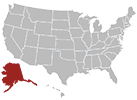
Becoming a sterile processing technician can be a very rewarding career choice.
Your training is relatively quick, you’ll be helping protect patients and doctors from infection, and you can make pretty good money.
In Alaska, it’s one of the better jobs for people who don’t want to undergo much training.
Thankfully, this process isn’t complex, and you should be able to handle it easily.
Page Navigation
Steps to Become a Sterile Processing Technician in Alaska
Alaska has no state certification or requirements for becoming a sterile processing technician.
Some people may apply for these jobs out of high school without training and start their careers.
Some hospitals hire people this way because they can train them and pay them less money.
However, getting certified in this career or earning an associate’s degree in medical assistance is advantageous.
While an associate’s degree isn’t required, hospitals in Alaska may look more favorably on you if you have a degree.
Most will prefer a Certified Registered Central Service Technician or CRCST certification.
This certificate typically takes less time to earn than an associate’s degree and is far less costly.
That makes it a good step for people who want to start this career as quickly as possible.
The steps below will help you prepare for this unique process speedily and effectively.
Getting Certified
Follow these basic steps to earn your sterile processing technician certification.
But, first, you’ll need to find a school where you can learn these schools.
Often, these facilities also serve as testing sites, meaning you can take your certification exam there.
Finish Your Basic Education
You’ll need a high school diploma or a GED to begin this certification process.
If you’re still in high school, complete your courses or take a GED if you dropped out.
Without these educational minimums, you won’t be able to begin certification.
Pass a Background Check
Certification facilities ask for a basic criminal background check and a drug test.
They often provide you with the paperwork to complete these exams, including processing your payment plans.
Once you’ve completed these tests, you can begin your program.
Complete a Program
A typical certification training program focuses on the essential skills necessary for this job, including sterilization, equipment storage, and more.
Depending on the facility, you’ll also complete many hours of clinical service.
Most programs take a few months to complete.
Work in an Internship or Externship
A typical internship or externship provides at least 40 hours of hands-on training in a medical facility.
Some programs may include more training time to meet your certificate requirements.
Pass the Certification Exam
Sign up for your certification exam after completing your internship or externship.
This test includes detailed information, questions about proper sterilization procedures, and much more.
Passing the same earns your certification and ensures you can start looking for careers.
Sterile Processing Technician Schools in Alaska
Alaska has a handful of schools, universities, and training facilities where you can earn the training necessary to begin your career.
They focus on providing you with the help you need to get certified as a sterile processing technician, including in-depth exams and clinical courses.
University of Alaska Anchorage
![]()
The University of Alaska Anchorage includes an in-depth program focusing on surgical technology.
Though focused more on a broader training program, you do learn sterilization procedures while completing this program.
You’ll also learn wound management and much more.
Expect your degree to take two years.
Alaska Job Center Network

The Alaska Department of Labor and Workforce Development provides on-the-job training for sterile processing technicians.
They’ll help connect you with a medical facility interested in this type of work and will ensure that you get the hands-on training you need to begin.
Training times will vary.
Ashworth College
![]()
Ashworth College includes an online program that you can earn in just four months.
You’ll learn about aseptic techniques, bloodborne pathogens, quality assurance, and proper sterilization methods.
Once you’re finished, you’re ready to take the CRCST certification exam.
Sterile Processing Technician Schools in Alaska – Summary Table
Top 3 Schools in Alaska
| School Name | Address |
|---|---|
| University of Alaska Anchorage | 3211 Providence Dr, Anchorage, AK 99508, USA |
| Alaska Job Center Network | 1251 Muldoon Rd, Anchorage, AK 99504, United States |
| Ashworth College | 5051 Peachtree Corners Circle, Suite 200. Norcross, GA 30092 |
Salary
A sterile processing technician makes an average of $51,444 annually in Alaska, with a low of $40,596.
However, you may earn up to $67,229 per year in some facilities, particularly if you have much experience or high-level training that improves your earning potential in this career.
For instance, team leaders make more money in this field.
Note that this is well above the national average ($45,891), low ($36,214), and high pay rates ($59,973).
This higher pay level is likely due to fewer people being available in Alaska, meaning that they must pay their medical employees higher to ensure they stay there.
That benefits you by ensuring you get paid a higher amount of money working in this field.
Annual Salary Range:Average Salary of Sterile Processing Technicians in Alaska
| City Name | Salary |
|---|---|
| Anchorage | $42,450 |
| Juneau | $42,070 |
| Fairbanks | $42,270 |
| Sitka | $41,500 |
| Ketchikan | $41,500 |
| Kenai | $41,879 |
| Palmer | $41,880 |
| Wasilla | $41,880 |
| Barrow | $41,700 |
| Bethel | $41,880 |
Regional Salary in Alaska
| Region | Employed | Avg. Annual Salary | Avg. Hourly Pay | Top 10% Annual Salary | Bottom 10% Annual Salary |
|---|---|---|---|---|---|
| Anchorage, AK | 120 | $52,840 | $25.4 | $66,420 | $39,990 |
* Employment conditions in your area may vary.
Frequently Asked Questions
Do I Need to Get a Certification to Start a Job in Alaska?
While you aren’t required to get a certification as a sterile processing technician, doing so can help you find a more manageable job.
In addition, many employers seek out employees with accreditation because they don’t have to train them and can easily transition them into a career.
How Well Does This Job Pay Compared to Other Alaska Careers?
While sterile processing technicians earn more than the national average in Alaska, the average salary in this state is $76,000 per year.
Most of the highest-paying jobs in Alaska are in the medical field, and many earn well over the national average.
Where Can I Get a Sterile Processing Technician Job in Alaska?
Medical facilities like Alaska Native Medical Center, Alaska Psychiatric Institute, Alaska Regional Hospital, Bartlett Regional Hospital, and Bassett Army Community Hospital may all hire sterile processing techs.
You may also find work at one of the many dental facilities in the area.
How Much Does My Certification Cost?
A CRCST certification typically costs around $125 and includes the test and paperwork required to apply.
If you need to retake this test for any reason, you will pay that fee again.
As a result, it is crucial to study carefully to ensure you fully understand this career’s scope.




